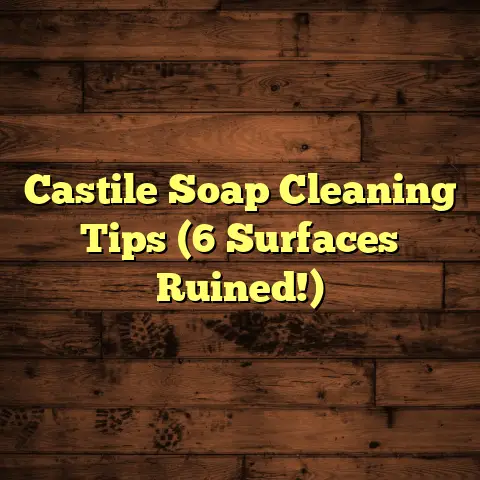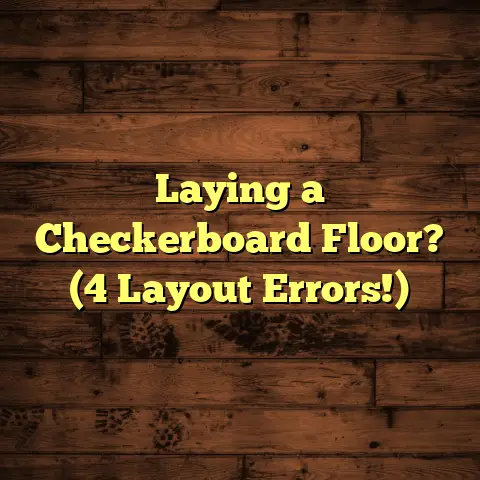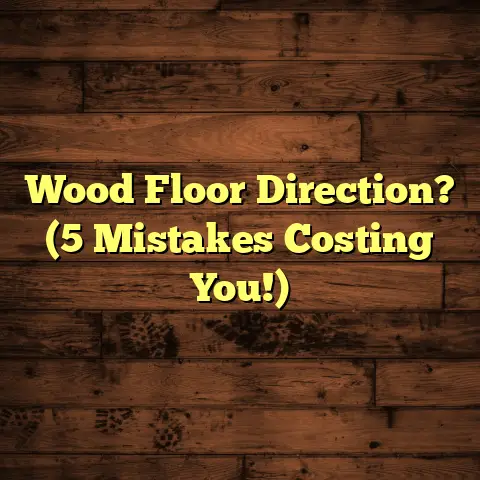How To Lay LVP Flooring? (5 Install Don’ts!)
Imagine stepping into your home, greeted by the warm, inviting look of luxurious vinyl plank (LVP) flooring underfoot.
It’s stylish, durable, and a fraction of the cost of hardwood.
But what if I told you that the difference between a flawless installation and a flooring disaster lies in five critical mistakes that many DIYers make?
Whether you’re renovating a single room or transforming your entire home, understanding these pitfalls can save you time, money, and a lot of frustration.
In this comprehensive guide, we’ll explore how to lay LVP flooring and highlight the five crucial “don’ts” that will ensure your project is a resounding success.
Section 1: Understanding LVP Flooring
So, what exactly is LVP flooring?
Well, it stands for Luxury Vinyl Plank, and it’s a type of flooring designed to mimic the look of real wood, tile, or stone.
But unlike those materials, LVP is made from synthetic materials, primarily PVC (polyvinyl chloride).
This makes it incredibly durable, water-resistant, and easy to maintain.
Think of it as the superhero of flooring!
Benefits of LVP:
- Water Resistance: Perfect for kitchens, bathrooms, and basements.
- Durability: Resists scratches, dents, and stains.
- Cost-Effective: Significantly cheaper than hardwood or tile.
- Easy Installation: DIY-friendly, especially click-lock systems.
- Variety: Available in countless styles and colors.
Compared to traditional flooring options, LVP offers a compelling alternative.
Hardwood, while beautiful, is susceptible to water damage and scratches.
Tile can be cold and hard underfoot.
Laminate, while cheaper, doesn’t offer the same level of water resistance as LVP.
The LVP Installation Process:
The LVP installation process generally involves preparing the subfloor, laying an underlayment (if needed), and then clicking or gluing the planks together.
It’s a project that many homeowners can tackle themselves, saving on labor costs.
Different Styles and Designs:
One of the best things about LVP is the sheer variety available.
You can find LVP that looks like:
- Oak
- Maple
- Hickory
- Stone
- Tile
And many more!
Plus, LVP comes in various sizes, textures, and finishes, allowing you to create a truly customized look.
Section 2: Preparing for Installation
Alright, let’s get down to the nitty-gritty.
Before you even think about laying that first plank, preparation is key.
Trust me, I’ve seen too many projects go south because of poor prep work.
Measuring the Space:
Accurate measurements are crucial.
You don’t want to end up short on materials or with awkward gaps.
Measure the length and width of the room, and then multiply those numbers to get the square footage.
Pro Tip: Always add 10% to your total square footage for waste and cuts.
It’s better to have extra than to run out mid-project.
Tools and Materials:
Here’s a list of the essential tools and materials you’ll need:
- LVP Flooring
- Underlayment (if required)
- Measuring Tape
- Utility Knife
- Straight Edge or T-Square
- Pencil
- Rubber Mallet
- Spacers
- Tapping Block
- Safety Glasses
- Knee Pads (trust me, your knees will thank you)
- Moisture Meter
- Level
- Broom or Vacuum
Preparing the Subfloor:
This is where a lot of DIYers drop the ball.
The subfloor is the foundation of your new floor, and it needs to be clean, level, and dry.
- Cleaning: Sweep or vacuum the subfloor thoroughly to remove any dirt, dust, or debris.
- Leveling: Use a level to check for any uneven spots.
Small imperfections can be fixed with a self-leveling compound.
Larger issues may require more extensive repairs. - Moisture Testing: Moisture is the enemy of LVP.
Use a moisture meter to check the moisture content of the subfloor.
According to the RFCI (Resilient Floor Covering Institute), the moisture content should be below 5% for concrete and between 6-8% for wood subfloors.
If the moisture levels are too high, you’ll need to address the issue before installing the LVP.
Acclimating LVP Planks:
Acclimation is the process of allowing the LVP planks to adjust to the temperature and humidity of the room where they will be installed.
How to Acclimate:
- Bring the LVP planks into the room where they will be installed.
- Leave the boxes unopened for at least 48-72 hours.
This allows the planks to adjust to the room’s environment, minimizing the risk of warping or gapping after installation.
Section 3: The Step-by-Step Installation Process
Okay, now for the fun part – actually laying the LVP!
Here’s a step-by-step guide to help you through the process:
Step 1: Planning the Layout and Starting Point
Before you start slapping down planks, take some time to plan your layout.
Consider the following:
- Direction: Which way do you want the planks to run?
Typically, running them parallel to the longest wall of the room makes the space look larger. - Starting Point: Choose a straight wall as your starting point.
This will help ensure that your rows are straight and even. - Offset: Decide on an offset pattern for the planks.
This means staggering the seams between rows for a more natural look.
A common offset is 6-8 inches.
Step 2: Installing the Underlayment (If Required)
Some LVP products come with an attached underlayment, while others require a separate underlayment.
Check the manufacturer’s instructions to determine if you need an underlayment.
If so, roll out the underlayment and secure it with tape.
Step 3: Laying the First Row of Planks
This is where the magic begins!
Place spacers along the wall to create an expansion gap (more on that later).
Then, starting at your chosen starting point, lay the first row of planks.
Use a tapping block and rubber mallet to gently tap the planks together, ensuring a tight fit.
Step 4: Continuing the Installation Row by Row
Continue laying the planks row by row, following your chosen offset pattern.
Use the tapping block and mallet to ensure a tight fit between planks.
As you work, double-check your alignment and make sure the planks are lying flat.
Step 5: Cutting Planks for Corners and Edges
Inevitably, you’ll need to cut planks to fit around corners, doorways, and along edges.
Use a utility knife and straight edge to score the plank, and then snap it along the scored line.
For more complex cuts, a jigsaw or miter saw can be helpful.
Step 6: Installing Transition Strips and Finishing Touches
Once the main flooring is installed, it’s time to add the finishing touches.
Install transition strips where the LVP meets other types of flooring, such as carpet or tile.
These strips provide a smooth transition and protect the edges of the flooring.
Finally, install baseboards or quarter-round molding to cover the expansion gaps along the walls.
Section 4: The 5 Install Don’ts
Alright, now for the most important part – the five critical “don’ts” that can make or break your LVP installation.
1. Don’t Skip Subfloor Preparation
I can’t stress this enough: subfloor preparation is non-negotiable.
A poorly prepared subfloor can lead to a host of problems, including:
- Uneven Surfaces: This can cause the LVP planks to flex and bend, leading to premature wear and tear.
- Warping: If the subfloor is uneven or has moisture issues, the LVP planks can warp and buckle.
- Gaps: Gaps between the planks can trap dirt and debris, making the floor difficult to clean and potentially leading to water damage.
Example: I once had a client who skipped leveling the subfloor, thinking it wasn’t that important.
Within a few months, the LVP planks started to separate, creating unsightly gaps and tripping hazards.
They ended up having to tear up the entire floor and start over, costing them a lot of time and money.
2. Don’t Ignore Expansion Gaps
Expansion gaps are small spaces left around the perimeter of the room to allow the flooring to expand and contract with changes in temperature and humidity.
Without these gaps, the flooring can buckle and warp as it expands, causing serious damage.
Why Expansion Gaps Are Important:
- Natural Expansion and Contraction: All flooring materials expand and contract to some degree.
LVP is no exception. - Prevent Buckling: Expansion gaps provide room for the flooring to move without putting pressure on the walls or other fixed objects.
- Maintain Appearance: Without expansion gaps, the flooring can buckle and warp, ruining the appearance of your new floor.
Example: I’ve seen floors buckle so badly that they actually lifted off the subfloor, creating a dangerous tripping hazard.
Always use spacers when installing LVP to ensure that you leave the proper expansion gap.
3. Don’t Forget to Acclimate the Planks
As I mentioned earlier, acclimation is the process of allowing the LVP planks to adjust to the temperature and humidity of the room where they will be installed.
Skipping this step can lead to:
- Cracking: If the planks are too dry when installed, they can crack as they absorb moisture from the air.
- Shrinking: If the planks are too moist when installed, they can shrink as they dry out, creating gaps between the planks.
- Warping: Acclimation helps the planks stabilize, reducing the risk of warping after installation.
Example: I had a customer who installed LVP in their basement without acclimating the planks.
A few weeks later, they called me complaining that the floor was cracking and gapping.
I had to explain that they had skipped a crucial step and that the only solution was to replace the entire floor.
4. Don’t Use Improper Adhesive or Underlayment
Using the wrong adhesive or underlayment can lead to a host of problems, including:
- Adhesive Failure: If the adhesive isn’t compatible with the LVP or subfloor, it can fail to bond properly, causing the planks to come loose.
- Moisture Issues: Some underlayments can trap moisture, leading to mold and mildew growth.
- Reduced Durability: The wrong underlayment can reduce the impact resistance of the LVP, making it more susceptible to dents and scratches.
Choosing the Right Products:
- Adhesive: Use an adhesive that is specifically designed for LVP flooring.
- Underlayment: Choose an underlayment that is compatible with LVP and suitable for your subfloor.
5. Don’t Rush the Installation
I know you’re excited to see your new floor, but rushing the installation can lead to costly mistakes.
Take your time, double-check your work, and make sure everything is done correctly.
Common Mistakes Made by Those Who Rush:
- Misaligned Planks: Rushing can lead to misaligned planks, creating an uneven and unprofessional look.
- Improper Cuts: Cutting corners (literally!) can result in poorly fitted planks around corners and edges.
- Skipping Steps: In a hurry, you might skip important steps like leveling the subfloor or using spacers.
Example: I once had a DIYer call me in a panic because they had rushed the installation and ended up with a floor that was completely crooked.
They had to tear up the entire floor and start over, costing them a lot of time and money.
Conclusion: Recap and Final Thoughts
As you embark on your journey to lay LVP flooring, remember that meticulous preparation and awareness of these five critical don’ts can make all the difference.
With the right knowledge and care, you can achieve a beautiful, long-lasting floor that enhances your home’s aesthetic and value.
Now, armed with this guide, you are well-equipped to tackle your LVP flooring project with confidence!





